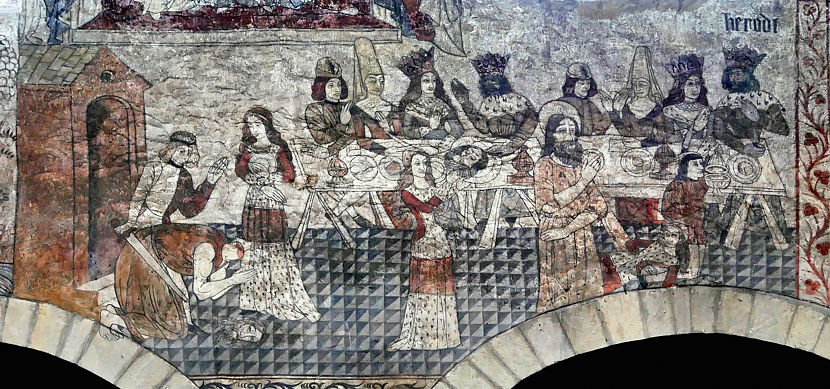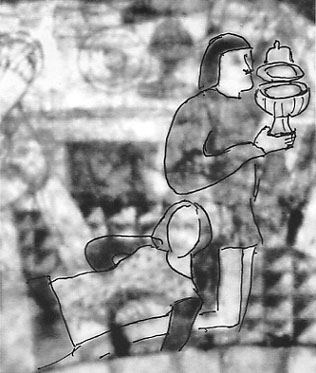Pickering, North Yorkshire (†York) Late C.15
The Martyrdom of St John the Baptist
Herod’s Feast, with Salome
“…And the king was exceeding sorry; yet for his oath’s sake,
and for their sakes that sat with him, he would not reject her…”
Mark 6:26

Reading from the left-hand margin, this example of the subject on the north nave wall at Pickering, shows the dark red prison-house where John the Baptist was confined for denouncing Herod’s marriage to Herodias, his brother Philip’s widow, as unlawful.
In the foreground John himself, in his rough garment, kneels on the chequerboard patterned floor, his hands clasped in prayer and his now detached head beside him, Salome, who as usual appears several times in this painted narrative, stands beside the head, clasping to her bosom the charger or dish on which she will present the Baptist’s head. A youthful executioner in a bi-coloured tunic has his sword lowered and his right hand raised.

Beyond this, moving right, is the long trestle table at which Herod sits with his guests – in fact only two people, one man and one woman wearing the tall hennin or steeple headdress. These two appear twice, as do Herod and his wife Herodias, both regally arrayed in crowns and lavish ermine collars. Salome herself appears a second time on the nearside of the table, presenting John’s head on the charger to Herod, who reaches towards it with his left hand, his right raised in shock, genuine or feigned. Herodias raises her hand to her bosom. Beyond to the right, the male and female guests appear again, then Herodias a second time, and finally Herod himself at the far end of the table, identifiable by the inscription Herodi above his head.
In front of the table, moving back in time, the story goes on. John, intact, stands with right hand raised and index finger extended to signify speech, while to the right of him, Salome performs her dance. She is very hard to see, given the heavily patterned floor, her apparently recumbent position on it, and her complicated gown with patterned (probably more ermine) bodice, contrasting red sleeves and horizontally banded skirt. The black and white detail at the right, with salient details outlined, should help. This writhing display is perhaps the most sexually explicit performance of any of Salome’s dances remaining on an English church wall. The Herod-Herodias-Baptist-Salome nexus creates, arguably, the most erotically charged incident in the Gospels, and artists of all kinds have always responded to it as such, as in Quentin Massys’ Lamentation Altarpiece. In the (zoomable) Massys panel, the ecstatic, sated faces of Herodias and Salome, the fallen-silent musicians in the gallery, the terrified little dog, are all eloquent testimony to its power.
At Pickering, a young page is beyond Salome, kneeling to serve his lord at table in conformity with standard practice in the medieval houses of the great. He too is outlined in the black-and-white photograph above, as he lifts the cover of an elaborate wine cup. There is significant symbolism here, I think – a foreshadowing of the fact that John’s decapitation is about to take place – his own lid will be off imminently. The painter was clearly determined to ensure that people in the church did not miss this detail, while at the same time creating a faithfully naturalistic account of a royal feast.
‘…For his oath’s sake, and for their sakes that sat with him, he would not reject her…’ No medieval king would dare break a publicly-sworn oath.² And in the Realpolitick world of 1st century Judaea, Herod the insecure puppet desperately needed allies. Two worlds, and two world-views, come together with brilliant economy in this remarkable painting. The Pickering artist may well have been, in modern terms, functionally illiterate, but he knew how to express psychological complexity in paint.
There are still a few more paintings to come from Pickering, and they will be here soon. Other wall paintings of Herod’s Feast are in the table below.
Website for SS Peter & Paul, Pickering
¹ Massys’ Lamentation Altarpiece, painted 1508-11, is in the Musée Royal, Antwerp. Herod’s Feast is on the left-hand panel.
² Although of course some did, invariably with disastrous consequences.
Photos: Helge Klaus Rieder CC0